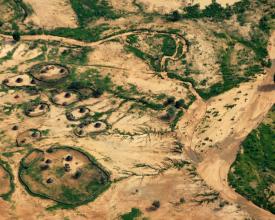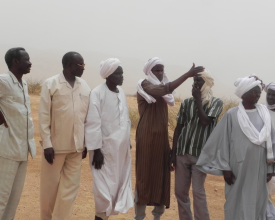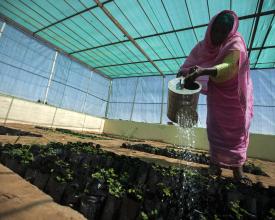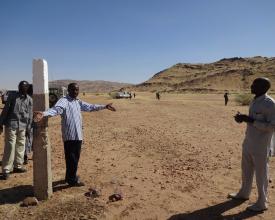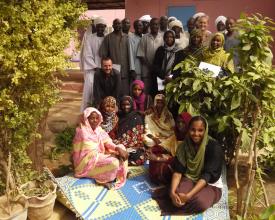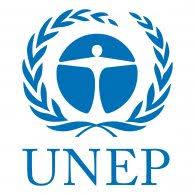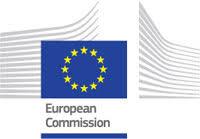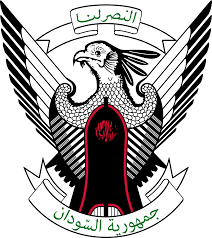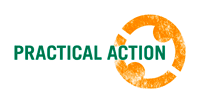
Seguridad alimentaria y resistencia a las catástrofes mediante la gestión sostenible de las zonas áridas

El proyecto utilizó una combinación de medidas basadas en el ecosistema (revegetación y protección del ecosistema) e infraestructuras grises (rehabilitación de una estructura de retención de agua) para aumentar la seguridad alimentaria frente a la sequía y las inundaciones repentinas, reforzando al mismo tiempo la gobernanza medioambiental a nivel local. El uso de un enfoque híbrido verde-gris es probablemente el más apropiado en el contexto de las tierras áridas de Sudán.
El proyecto adoptó un enfoque de reducción del riesgo de catástrofes basado en los ecosistemas (Eco-DRR) trabajando en un marco de amenazas (sequía e inundaciones repentinas), vulnerabilidad (debido a la zona de conflicto y a prácticas insostenibles) para reducir el riesgo de catástrofes (por ejemplo, hambruna). Sin embargo, la sequía y la irregularidad de las precipitaciones están aumentando debido al cambio climático, por lo que las medidas basadas en los ecosistemas que se adoptan también permiten la adaptación (por lo que también son EbA).
Contexto
Défis à relever
Dafur se enfrenta a sequías e inundaciones repentinas que empeoran debido al cambio climático y la desertificación. También hay un trasfondo de agitación política y conflicto. Un grupo rebelde controló la zona entre 2004 y 2011. El conflicto de Dafur desplazó a la población y exacerbó el uso insostenible de los recursos naturales, lo que ha provocado tensiones y conflictos entre los distintos usos de los recursos (por ejemplo, entre agricultores y pastores).
Ubicación
Procesar
Resumen del proceso
La creación de asociaciones y el compromiso de las comunidades (building block 1) son los cimientos de la aplicación de intervenciones adecuadas sobre el terreno (building block 2) y la mejora de la gobernanza de los recursos naturales (building block 3). Por último, el desarrollo de capacidades a nivel local y nacional para la adopción de medidas basadas en los ecosistemas (building block 4) garantiza la sostenibilidad de las intervenciones.
Bloques de construcción
Creación de asociaciones y compromiso comunitario
Crear asociaciones sólidas a nivel local y nacional y trabajar con la comunidad local es esencial para la ejecución y el éxito general y la sostenibilidad del proyecto.
Además, era esencial conectar a las comunidades locales con los organismos gubernamentales y garantizar que el Estado asumiera como propias las actividades, de modo que en el futuro se pudiera solicitar ayuda al gobierno.
Factores facilitadores
El PNUMA contaba con sólidas asociaciones de larga data (con partes interesadas locales y socios ejecutores locales y nacionales) en la zona del proyecto.
Lección aprendida
En un contexto frágil como el de Sudán, contar con asociaciones duraderas es vital para el éxito del proyecto.
Durante la ejecución de las actividades comunitarias se aprendió que los proyectos a nivel comunitario deben exigir el mínimo de tiempo y energía a los miembros de la comunidad, y garantizar el calendario adecuado de actividades para que se ajusten a los horarios de las comunidades, ya que las actividades del proyecto suelen requerir trabajo voluntario.
Además, cuando las comunidades ven pruebas claras de los beneficios de las intervenciones, se muestran más dispuestas a poner en marcha y continuar con actividades similares por su cuenta en el futuro. Las intervenciones que muestran menos beneficios directos para los medios de subsistencia requieren un buen diálogo y campañas de sensibilización.
Intervenciones sobre el terreno
Las intervenciones sobre el terreno fueron
- Rehabilitación de una estructura hidráulica para aumentar los cultivos y reverdecer el uadi (infraestructura gris)
- Creación de viveros comunitarios
- Reforestación comunitaria
- Resiembra de pastos
- Control de la erosión del suelo para solucionar el problema de la erosión de los barrancos de la zona (mediante terraplenes y diques de contención con material local).
Todos los proyectos se llevaron a cabo con la participación de la comunidad. Grupos de mujeres gestionan los viveros y los bosques comunitarios. Cuatro de los cinco bosques se crearon con plántulas del vivero, mientras que el bosque natural de una aldea se rehabilitó y se está protegiendo del pastoreo.
Factores facilitadores
Hubo una gran aceptación por parte de la comunidad local, que contribuyó sustancialmente con mano de obra en especie para las intervenciones sobre el terreno, que fueron claramente beneficiosas para ellos.
Lección aprendida
Diseñar las intervenciones adecuadas basadas en el ecosistema fue todo un reto debido a la limitada disponibilidad de agua y a que la vegetación joven es más vulnerable a los periodos de sequía. Por tanto, la prioridad era el acceso al agua y la mejora de los medios de subsistencia. De hecho, los árboles plantados se talarían si no se mejoraban también los medios de subsistencia por otros medios. Así pues, era necesaria una combinación de infraestructuras grises y verdes. Rehabilitar una estructura de retención de agua, mejorar los rendimientos agrícolas y reverdecer el paisaje al tiempo que se eliminaba la presión sobre los suelos más frágiles.
Proteger los bosques recién plantados del pastoreo no siempre fue fácil. Tras debatirlo con la comunidad, se acordó poner en marcha un sistema de control rotativo para garantizar la vigilancia contra el pastoreo incontrolado. Los proyectos futuros podrían beneficiarse de la selección de especies forestales que requieran una protección mínima, por ejemplo árboles y arbustos poco apetecibles.
Gobernanza de los recursos naturales
El objetivo del proyecto era mejorar la gobernanza de la tierra y los recursos hídricos a nivel comunitario para aumentar la resiliencia de las comunidades ante los riesgos hídricos y promover una gestión sostenible de las zonas áridas. Para ello se adoptaron varias medidas
- Creación de un comité de gestión de los recursos hídricos responsable de la estructura de retención del agua, de la alerta temprana y la preparación ante inundaciones y sequías, y de garantizar la distribución proporcional del agua. El comité también sirve de enlace con programas más amplios de gestión del paisaje y con el gobierno y las ONG.
- Demarcación de la ruta migratoria de las comunidades de pastores para reducir los posibles conflictos por la entrada de animales en las tierras de labranza y de granjas que invaden los pastizales.
- Establecimiento de fondos rotatorios para la agricultura (banco de semillas) y la ganadería con el fin de sostener las actividades de subsistencia y proporcionar servicios continuados a largo plazo.
Factores facilitadores
El proyecto Eco-DRR complementó otra iniciativa de mayor envergadura del PNUMA, conocida como Proyecto de Gestión de la Captación del Wadi El-Ku (WEK) en Darfur del Norte, ejecutado a lo largo del mismo wadi y más o menos al mismo tiempo. El proyecto WEK demuestra cómo una gestión eficaz e integradora de los recursos naturales puede mejorar las relaciones sobre los recursos naturales, contribuyendo así a la consolidación de la paz y a la mejora de los medios de subsistencia de las comunidades afectadas por el conflicto.
Lección aprendida
La gobernanza de los recursos naturales requiere el diálogo entre las partes interesadas para comprender las necesidades de las comunidades implicadas y para aplicar con éxito las medidas. Además, implicar a las autoridades necesarias (por ejemplo, vincular el comité de gestión del agua con el gobierno y las ONG para obtener asistencia técnica y financiación; e implicar al gobierno y a todas las partes interesadas para la demarcación de la ruta migratoria) ayuda a garantizar la sostenibilidad del proyecto. También es importante que estas actividades se reproduzcan a través de otros proyectos (por ejemplo, WEK y otros proyectos). De hecho, la demarcación de la ruta migratoria se amplió de los 10KM a una ruta total de 120KM.
Refuerzo de las capacidades locales y nacionales
El proyecto invirtió significativamente en el desarrollo de capacidades a nivel local y nacional mediante la concienciación sobre EbA/Eco-DRR, actividades prácticas de aprendizaje sobre el terreno y talleres de formación. El proyecto se aseguró de que las mujeres estuvieran entre los formados en todas las actividades.
La capacitación local se centró principalmente en las cinco aldeas en las que se llevaron a cabo las intervenciones, pero también contó con la participación de representantes de las aldeas que participaron en la ampliación de las intervenciones del proyecto a una zona más extensa del uadi en la sección aguas arriba. La sensibilización promueve el diálogo sobre los ecosistemas de las tierras secas y las cuestiones relacionadas con la gestión del riesgo de catástrofes.
Se formó a agentes de extensión agraria (2 en cada aldea) debido a la limitada presencia del Gobierno en las aldeas para prestar servicios de apoyo a la extensión agraria. Además, ocho trabajadores comunitarios de sanidad animal, también llamados "paravets", recibieron formación sobre cría de animales, tratamiento, medicamentos para animales, alimentación y vacunación, a través de sesiones teóricas y prácticas. Los "paravets" también supervisaron los pastos resembrados.
También se impartió formación a nivel nacional y estatal sobre Eco-DRR.
Factores facilitadores
La mayor parte del desarrollo de capacidades tuvo lugar sobre el terreno, como parte del "aprendizaje práctico" mediante la ejecución de intervenciones sobre el terreno como el establecimiento y la gestión de viveros, la resiembra de pastizales y la reforestación.
Lección aprendida
Las formaciones de capacitación local impartidas a las comunidades mejoran las posibilidades de continuidad en la gestión de las intervenciones sobre el terreno.
El taller a nivel estatal inició una serie de diálogos en Darfur septentrional sobre la importancia de establecer un foro que sirva de plataforma para una gestión de los recursos naturales que sea a la vez integradora y consciente de los peligros relacionados con el agua. La realización de este tipo de cursos de formación a nivel nacional y estatal ayuda a incorporar medidas basadas en los ecosistemas en las políticas y programas nacionales. De hecho, la GIRH se identificó como una medida clave para reducir los riesgos de catástrofe y adaptarse al cambio climático y a los fenómenos meteorológicos extremos, lo que se reflejó en la Agenda Nacional de Acción, que fue el principal resultado de la formación nacional.
Impactos
El proyecto mejoró la seguridad alimentaria y redujo la vulnerabilidad a la sequía de 17.500 personas. Gracias a la mejora del sistema de retención de agua, el aumento de las cosechas durante un buen año de lluvias en 2014 ayudó a salvar la brecha alimentaria causada por el fracaso de la temporada de lluvias en 2015. El aumento de las tierras de cultivo también se destinó a los hogares vulnerables y les ayudó a beneficiarse de una mayor producción agrícola, reduciendo al mismo tiempo la presión sobre el paisaje circundante.
La resiliencia medioambiental también aumentó con la creación de bosques comunitarios y la resiembra de pastos. De este modo se protegió de la erosión, se revegetó y reverdeció el paisaje y se obtuvieron ingresos adicionales para los hogares en el futuro gracias a la recolección de goma arábiga.
Los conflictos por los recursos naturales se redujeron gracias a la creación de un comité de gestión del agua, la demarcación de una ruta migratoria para los pastores y las consultas periódicas a las partes interesadas.
Beneficiarios
17.500 habitantes de una población total de 30.000 en cinco pueblos (Eid El Beida, Abudelik, Bahr Omdurman, Wad Kota, Waa'dha) de la localidad de Kilimondo, Darfur Norte.
Objetivos de Desarrollo Sostenible
Historia
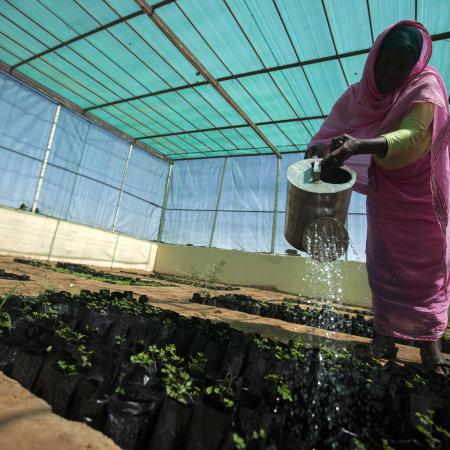
La degradación medioambiental debida a la interacción de la irregularidad periódica de las lluvias, que aumenta con el cambio climático, y la presión demográfica, la agricultura insostenible, la deforestación y el pastoreo excesivo han reducido la capacidad de las zonas áridas para mantener los medios de subsistencia locales. También se producen conflictos por el uso del agua y los recursos entre los grupos de pastores y las comunidades agrícolas.
El proyecto, financiado por la Comisión Europea, dirigido por el PNUMA y Practical Action Sudan entre 2012-2015, en asociación con las comunidades locales y el gobierno estatal, ganó el premio Land for Life 2017 por mejorar la seguridad alimentaria y la resiliencia ante los desastres y reducir las tensiones comunitarias mediante la gestión sostenible de las zonas áridas del norte de Dafur.
Las numerosas actividades del proyecto en Wadi El Ku incluyeron una combinación de infraestructuras verdes y grises.
Antes de rehabilitar una estructura de retención de agua existente (una medida de infraestructura gris), se llevó a cabo una evaluación del impacto social y medioambiental para identificar y mitigar cualquier posible impacto negativo. Esta estructura también mejorará la infiltración del agua en el suelo, aumentará la productividad de los cultivos y evitará la erosión de los barrancos río abajo, al tiempo que pondrá en cultivo 6300 ha de tierra fértil de los uadis (en lugar del frágil paisaje circundante), impulsando la producción agrícola. La comunidad local colaboró voluntariamente en esta obra de rehabilitación, aumentando su sentimiento de propiedad.
Las medidas de infraestructura verde fueron los bosques comunitarios y la rehabilitación de pastizales. Se creó un vivero local, gestionado por un grupo de mujeres, para apoyar la silvicultura comunitaria y la agrosilvicultura doméstica, al tiempo que se reverdeció el paisaje. De hecho, se crearon cuatro bosques comunitarios en cuatro pueblos (también gestionados por mujeres), mientras que en un pueblo se protegió un bosque natural. Se resembraron 1214 hectáreas de pastos.
Se mejoró la gobernanza de los recursos naturales mediante:
- la creación de un comité de gestión de los recursos hídricos
- demarcación de la ruta migratoria de las comunidades de pastores; y
- la creación de fondos rotatorios para medicamentos agrícolas y ganaderos.
Por último, se crearon capacidades a nivel local y nacional sobre estas medidas mediante actividades de sensibilización, talleres de formación y actividades de aprendizaje práctico en los lugares de demostración sobre el terreno.
